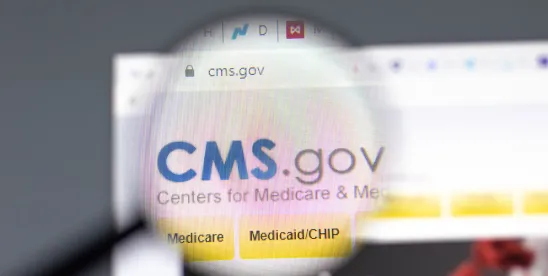On 1 November 2022, the Centers for Medicare & Medicaid Services (CMS) published the 2023 Hospital Outpatient Prospective Payment System (OPPS) and Ambulatory Surgical Center (ASC) Payment System final rule (the OPPS Final Rule or the Rule).1 In addition to finalizing policies related to the OPPS and ASC payment system for calendar year (CY) 2023, the Rule also finalized a number of provisions related to the new rural emergency hospital (REH) provider type, including policies addressing REH payment, enrollment, the Conditions of Participation (CoPs), quality reporting, and the federal physician self-referral law (Stark Law).
As discussed in our recent client alerts on REHs—available here and here—that described the proposed CoPs for REHs2 and the proposed enrollment and payment policies for REHs in the 2023 OPPS and ASC Payment System proposed rule,3 the REH provider category was established by Section 125 of the Consolidated Appropriations Act, 2021.4 Rural hospitals with not more than 50 beds and critical access hospitals (CAHs) that were enrolled in Medicare as of 27 December 2020 may apply to convert to and enroll in Medicare as an REH, and Medicare-enrolled REHs will receive payment for REH services provided on or after 1 January 2023.
For ease of reference, this client alert is divided into two parts. This is Part 1, which focuses on the payment and quality reporting policies for REHs finalized in the OPPS Final Rule. Part 2, which focuses on the REH policies finalized in the Rule for enrollment and CoPs is available here.5 In particular, we highlight below the areas of note where the payment and quality reporting policies finalized in the OPPS Final Rule contain modifications or clarifications to the proposed policies in those areas, as described in our prior alerts.
KEY FINALIZED POLICIES FOR REHS: PAYMENT AND QUALITY REPORTING
Summary
As discussed in more detail below, CMS finalized the payment policies for REH services and non-REH services as proposed while slightly modifying the monthly REH facility payment, resulting in an increase of nearly 2% over the proposed amount. REH services will be paid at OPPS payment rates increased by 5%, and non-REH Services will be paid at the same rate the service would be paid if performed in a hospital outpatient department.
With respect to quality reporting, CMS will implement a mandatory quality reporting program for REHs. The Rule provides some insight into CMS’s likely direction going forward but indicates that the particular quality measures to be used will be addressed in future rulemaking. In the interim, REHs will be required to establish a QualityNet account and to designate a security official for purposes of data submission and access to facility-level quality reports.
The finalized policies for REHs should cause CAHs and rural hospitals considering whether to convert to REHs to assess the areas in which they are located and analyze the potential regulatory and financial implications resulting from such conversion. In addition to weighing the potential economic benefits with the necessary organizational changes, a hospital considering REH conversion also should calculate whether revenue lost from the elimination of inpatient care and the move away from cost-based payment (for CAHs) can be offset by the payment amounts for REH services as well as the monthly facility payment.
Finalized REH Payment Provisions
Definition of REH Services and Payment for REH Services and Non-REH Services
CMS finalized as proposed the definition of REH services6 and payment for REH services7 and non-REH services8 as described in our prior alert. As such, REH services are defined as “all covered outpatient department services, other than inpatient hospital services as described in section 1833(t)(1)(B)(ii), that would otherwise be paid under the OPPS” and will be paid at OPPS payment rates increased by 5%.9 Non-REH services, such as laboratory services paid under the Clinical Laboratory Fee Schedule and certain diagnostic services not paid under the OPPS, will be paid under the applicable fee schedule without the additional 5% payment increase applied to REH services.10
CMS clarified a few payment-related items of note as part of responding to comments:
-
CAH Method II payment methodology for billing physician services is only available to CAHs; as such, physician services provided in an REH will be paid under the Medicare Physician Fee Schedule because REHs are not CAHs.11
-
Requests for modifications to the 340B Drug Pricing Program to permit REHs to be eligible to participate are outside the scope of the OPPS Final Rule, as the 340B Drug Pricing Program is outside of the jurisdiction of CMS and instead handled by the Health Resources and Services Administration.12
-
CMS did not propose a policy to designate REHs as graduate medical education eligible facilities, but noted it would consider this item for future rulemaking.13
-
With regard to packaging of laboratory services, the same rules apply for REHs as for OPPS hospitals.14
Payment for an Off-Campus Provider-Based Department of an REH
CMS finalized its proposal that Section 603 of the Bipartisan Budget Act of 2015, which applies to nonexcepted items and services furnished by nonexcepted off-campus provider-based departments (PBDs) of hospitals paid under the OPPS, would not apply to off-campus PBDs of REHs.15 CMS clarified that if a provider-based rural health clinic (RHC) was entitled to “grandfathering” under RHC payment rules by virtue of being in existence on 31 December 2020 and forward, then that RHC could continue to utilize the exceptions set out in Section 1833(f) of the Social Security Act if its associated hospital converts to an REH.16
Monthly REH Facility Payment
The OPPS Final Rule contains a detailed discussion of certain corrections and modifications to CMS’s methodology for calculating the monthly REH facility payment.17 Based on CMS’s finalized calculations, the REH monthly facility payment for CY 2023 will be US$272,866,18 an increase of nearly 2% from the proposed amount of US$268,294. The methodology for calculating the REH monthly facility payment in CY 2024 and subsequent years was finalized as proposed.19 CMS clarified that all REH payments, including the REH monthly facility payment, will be subject to Medicare sequestration.20
Cost Reporting and Other Reporting Requirements
CMS finalized its proposals related to REH cost reporting and associated requirements without modification.21 CMS declined a request that it develop an REH-specific cost report, stating that REH providers will continue to use their current cost reporting formats. CMS plans to monitor this issue and consider the need for REH-specific cost reporting in future rulemaking.22
CMS finalized a requirement that an REH that receives the additional facility payment is required to maintain detailed information as to how the facility spent the additional payments.23 In commentary, CMS noted its belief that this requirement can be met using existing cost reporting requirements for outpatient hospital facilities, which would include REHs. According to CMS:
The cost reports track spending on outpatient hospital services as a part of overall provider spending. This information will show if a sufficient share of revenue to the REH, which includes the monthly facility payment, is being directed to outpatient care. For CY 2023, we therefore did not propose to establish any new reporting or data collection requirements for REHs related to their use of the REH monthly facility payments.24
CMS plans to monitor this issue in CY 2023 to assess any need to propose new reporting or data collection requirements for REHs in future rulemaking.25
Finalized REH Quality Reporting Provisions
Similar to other hospital provider types, CMS will be implementing a mandatory quality reporting program for REHs, known as the Rural Emergency Hospital Quality Reporting (REHQR) Program. Many specifics of the REHQR Program, including the quality measures that will be used, are not finalized in the OPPS Final Rule, but will be addressed in future rulemaking. However, the Rule does finalize a few parameters of the REHQR Program and also provides some insight into CMS’s likely direction going forward.
Specifically, CMS finalized that REHs will be required to establish a QualityNet account and to designate a security official for purposes of data submission and access to facility-level quality reports.26 These requirements are consistent with other hospital quality programs. In terms of potential quality measures, CMS highlighted that one significant consideration will be to identify measures that reflect a sufficient volume of services for a sufficient number of REHs, particularly given that REHs will be smaller, rural hospitals that generally have more limited resources than other hospital provider types.27 In general, CMS indicated a preference to select measures endorsed by the National Quality Forum (NQF), but stated it may deviate from that preference where there is no NQF-endorsed measure for a given facility setting, procedure, or other aspect of care.28
As with other quality programs, CMS emphasized that it will seek to identify measures that can be used to measure health equity, including demographic characteristics and social determinants of health, and that quality measurement should include stratified results and demographic information.29 CMS also may seek to alleviate reporting requirements for REHs by utilizing Medicare claims-based measures or digital quality measures and, where possible, by aligning REHQR quality measures with other quality reporting programs.30
WHAT’S NEXT
The finalized policies for REHs will take effect on 1 January 2023. When determining whether to convert to an REH, eligible CAHs and rural hospitals should carefully assess the implications of this change in provider type, including from financial and regulatory perspectives. Among other considerations, such an assessment should review the payment and quality reporting policies for REHs, as well as relevant state-level authorities, such as requirements related to facility licensure and certificates of need, where applicable. Given that the conversion to an REH will result in significant changes to Medicare reimbursement and the services offered, hospitals should consider whether REH conversion is a viable option.
FOOTNOTES
1 Medicare Program: Hospital Outpatient Prospective Payment and Ambulatory Surgical Center Payment Systems and Quality Reporting Programs; Organ Acquisition; Rural Emergency Hospitals: Payment Policies, Conditions of Participation, Provider Enrollment, Physician Self-Referral; New Service Category for Hospital Outpatient Department Prior Authorization Process; Overall Hospital Quality Star Rating; COVID-19, CMS-1772-FC, (Nov. 1, 2022), https://public-inspection.federalregister.gov/2022-23918.pdf.
2 Medicare and Medicaid Programs; Conditions of Participation (CoPs) for Rural Emergency Hospitals (REHs) and Critical Access Hospital CoP Updates, 87 Fed. Reg. 40,350 (proposed July 6, 2022) (to be codified in a new subpart E of 42 C.F.R. pt. 485).
3 Medicare Program: Hospital Outpatient Prospective Payment and Ambulatory Surgical Center Payment Systems and Quality Reporting Programs; Organ Acquisition; Rural Emergency Hospitals: Payment Policies, Conditions of Participation, Provider Enrollment, Physician Self-Referral; New Service Category for Hospital Outpatient Department Prior Authorization Process; Overall Hospital Quality Star Rating, 87 Fed. Reg. 44,502 (proposed July 26, 2022).
4 Pub. L. No. 116-260 (Dec. 27, 2020).
5 A separate client alert on the Rule’s finalized Stark Law policies for REHs is forthcoming.
6 OPPS Final Rule, CMS-1772-FC at 1093.
7 Id. at 1097.
8 Id. at 1102.
9 Id. at 21.
10 Id.
11 Id. at 1093.
12 Id. at 1096.
13 Id. at 1096-97.
14 Id. at 1100-01.
15 Id. at 1107.
16 Id.
17 Id. at 1108-55.
18 Id. at 1155.
19 Id.
20 Id. at 1153.
21 Id. at 1161.
22 Id. at 1118-19.
23 Id. at 1112 (codified at 42 C.F.R. § 419.92(b)(3)).
24 Id. at 1112.
25 Id. at 1112, 1120.
26 Id. at 1049-51.
27 Id. at 1022-27.
28 Id. at 1022.
29 Id. at 1028-29.
30 Id. at 1026-27.
Ashley E. Davis also contributed to this article.





 />i
/>i

